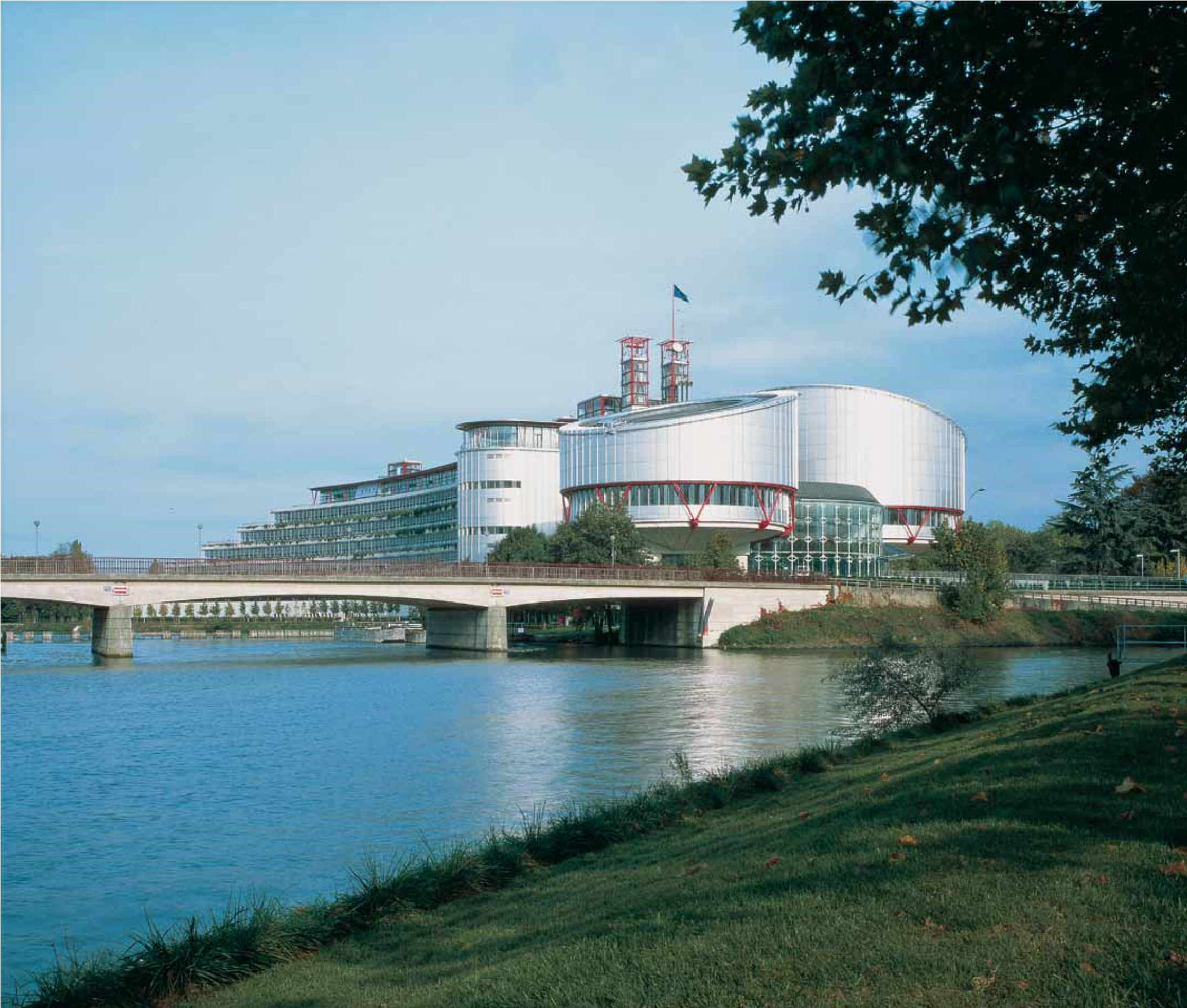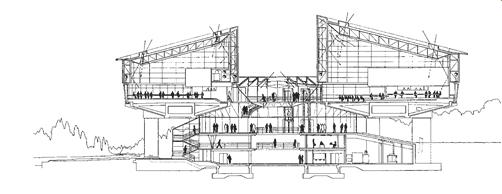European Court of Human Rights
The form of the building, dictated by the sweep of the river Ill, and the work of landscape architect Dan Kiley has resulted in a scheme where building and landscape interact seamlessly.
The European Court of Human Rights is a key building in the history of the Richard Rogers Partnership (RRP, now Rogers Stirk Harbour + Partners, RSH+P) and one of the few landmarks which provide a credible architectural image for the new Europe.
The site is located some way from the historic centre of the city but close to the river. The design creates a symbolic landmark but not a monument: the nature of the Court’s business implies that its premises should be anything but intimidating or fortress-like. Rather it should be welcoming and humane, while preserving an appropriate dignity. Protecting and enhancing the quality of the site was a prime objective, along with economy of operation and a ‘natural’ environment.
The basic diagram of the scheme was tested to its limits during the design process. The collapse of the communist bloc greatly increased the European ‘family’: the building’s office provision had to grow by some 50 per cent and the public spaces by 25 per cent.
The two main departments of the European Court, the Court itself and the Commission, occupy two circular chambers, clad in stainless steel, at the head of the building, while secondary structural elements are picked out in bright red. The entrance hall is light-filled, and has fine views out over the river. The ‘tail’ of the building is divided into two parts and contains offices, administration and the judge’s chambers. Functions are clearly legible. Only the main public spaces, focusing on a stone-paved rotunda, are air-conditioned (using an economical heat-exchange system). The remainder of the building relies on natural ventilation and light with opening windows.
Façades provide for a high degree of planting: well established greenery spills down from the roofs. The building is a powerful and highly rational expression of the function it serves but is imbued too with a Mendelsohnian streak of romantic expressionism.
Project information:
- Place/Date: Strasbourg , France 1989 - 1995
- Client: Conseil de l’Europe
- Cost: £35 million
- Area: 300,000 m²
- Cost/m²: £117
- Architect: Richard Rogers Partnership
- Structural Engineer: Ove Arup & Partners/Omnium Technique Européen
- Services Engineer: Ove Arup & Partners/Omnium Technique Européen
- Quantity Surveyor: Thorne Wheatley Associates
- Main Contractor: Campenon Bernard SGE
- Lighting Consultant: Lighting Design Partnership
- Landscape Architect: David Jarvis Associates/Dan Kiley
- Co-Architect: Atelier d’Architecture Claude Bucher
- Acoustic Consultant: Sound Research Laboratories
--RSHP
Featured articles and news
RTPI leader to become new CIOB Chief Executive Officer
Dr Victoria Hills MRTPI, FICE to take over after Caroline Gumble’s departure.
Social and affordable housing, a long term plan for delivery
The “Delivering a Decade of Renewal for Social and Affordable Housing” strategy sets out future path.
A change to adoptive architecture
Effects of global weather warming on architectural detailing, material choice and human interaction.
The proposed publicly owned and backed subsidiary of Homes England, to facilitate new homes.
How big is the problem and what can we do to mitigate the effects?
Overheating guidance and tools for building designers
A number of cool guides to help with the heat.
The UK's Modern Industrial Strategy: A 10 year plan
Previous consultation criticism, current key elements and general support with some persisting reservations.
Building Safety Regulator reforms
New roles, new staff and a new fast track service pave the way for a single construction regulator.
Architectural Technologist CPDs and Communications
CIAT CPD… and how you can do it!
Cooling centres and cool spaces
Managing extreme heat in cities by directing the public to places for heat stress relief and water sources.
Winter gardens: A brief history and warm variations
Extending the season with glass in different forms and terms.
Restoring Great Yarmouth's Winter Gardens
Transforming one of the least sustainable constructions imaginable.
Construction Skills Mission Board launch sector drive
Newly formed government and industry collaboration set strategy for recruiting an additional 100,000 construction workers a year.
New Architects Code comes into effect in September 2025
ARB Architects Code of Conduct and Practice available with ongoing consultation regarding guidance.
Welsh Skills Body (Medr) launches ambitious plan
The new skills body brings together funding and regulation of tertiary education and research for the devolved nation.
Paul Gandy FCIOB announced as next CIOB President
Former Tilbury Douglas CEO takes helm.
UK Infrastructure: A 10 Year Strategy. In brief with reactions
With the National Infrastructure and Service Transformation Authority (NISTA).

























